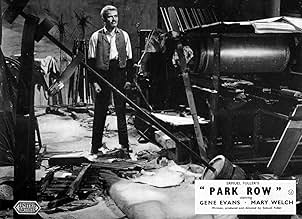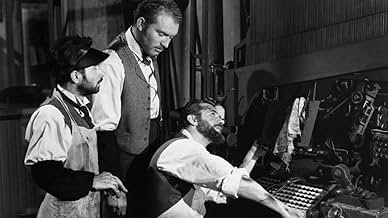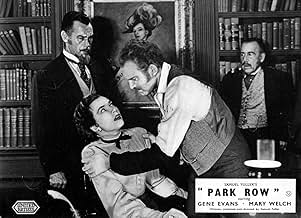Aggiungi una trama nella tua linguaThe Globe is a small, but visionary newspaper started by Phineas Mitchell, an editor recently fired by The Star. The two newspapers become enemies, and the Star's ruthless heiress Charity Ha... Leggi tuttoThe Globe is a small, but visionary newspaper started by Phineas Mitchell, an editor recently fired by The Star. The two newspapers become enemies, and the Star's ruthless heiress Charity Hackett decides to eliminate the competition.The Globe is a small, but visionary newspaper started by Phineas Mitchell, an editor recently fired by The Star. The two newspapers become enemies, and the Star's ruthless heiress Charity Hackett decides to eliminate the competition.
- Regia
- Sceneggiatura
- Star
- Jenny O'Rourke
- (as Tina Rome)
- Barfly
- (non citato nei titoli originali)
- Barfly
- (non citato nei titoli originali)
- Irate Liberty Fund Contributor
- (non citato nei titoli originali)
- Barfly
- (non citato nei titoli originali)
Recensioni in evidenza
Our story proper begins in that most Fuller-ish of places, a saloon. There, a bunch of hacks on New York's bestselling daily, The Star, spends their evenings swilling booze and exchanging dreams and bitter bon mots. When idealistic reporter Gene Evans takes a break from the bar to nail an epitaph to the grave of an executed man that reads 'Murdered by The Star' – an acerbic bolt of pure fury from Fuller that's among the neatest things he ever did – the 'paper's owner (Mary Welch) marches in, sacking him and his chums on the spot.
So Evans starts up the 'paper he's always dreamt of – The Globe – and cheery, impressionable young buck George O'Hanlon throws himself off the Brooklyn Bridge for a laugh, giving him a first-rate first splash. But Welch doesn't take such competition lying down, especially not from a man she quite fancies, and so begins a circulation war that spills over into resentment, hatred and good old-fashioned violence.
As you would expect, Fuller has a real feel for the material, filling his script with the usual insider terminology and slang. Leaving just enough in his account for some vodka and cigars, the writer-director-producer spent the rest of his savings – some $200,000 accrued making hit war films – on this pet project. Much of the cash went on a fastidiously complete recreation of the Park Row of his memory, including a multitude of four-storey buildings. The film's designers queried his logic, saying the tops of the structures would never be seen on camera. Fuller said he didn't care: "I had to see it all. I had to know everything was there, exact in every detail." The sets are constructed in an ingenious way that allows Fuller's camera to wind his way through the nooks and crannies of the offices, the intensity of the shooting schedule belied by the wealth of innovation behind the camera. The director's crab dolly, a wheeled platform that allowed the camera to move in any direction, aids the spectacular direction, getting us up close and personal during Evans' periodic stomps up and down the titular street, generally looking for someone to thump.
Park Row is a punchy, sometimes dynamic blend of heartfelt sentiment and acerbic cynicism that could only have come from one director. Whilst it occasionally appears over-earnest or self-congratulatory, and has too much repetition across its 80 minutes, it's flavourful and immersive, with a no-name cast that ideally suits its ink-stained universe.
Never did Fuller create a film of such sheer energy and nostalgia. The film's tracking shots and frenetically-edited montages seem to get the most attention, but there are also some great monologues and magnificent performances, particularly from Mary Welch as the head of the "evil" newspaper, The Star, and Gene Evans as the leader of their opposing newspaper, The Globe.
The film has it's moments of campiness, but overall it's one of cinema's overlooked classics.
The IMDb reviewer, st-shot, who called this movie a "valentine" hit the mark. This valentine has a fair amount going for it, but it's more flawed than faithful. A newspaperman himself (ca. 1930), Fuller prided himself on the historical accuracy of "Park Row" and there is truth behind, if not in, many of the people and events alluded to in the screenplay: The base of the Statue of Liberty, which was unveiled in 1886 when the movie takes place, was indeed partly paid for by a newspaper campaign (Joseph Pulitzer's "New York World"). A Bowery bookie named Steve Brodie did claim to have jumped off the Brooklyn Bridge that same year, and survived to both acclaim and controversy. Linotype was indeed invented by German immigrant Ottmar Mergenthaler in 1886, but it wasn't for a Park Row newspaper, it was for lawyers wanting a way to get legal papers printed faster. The young political cartoonist called "Thomas Guest" is obviously a thinly veiled Thomas Nast, who would have been in his mid-40s and very famous by 1886.
Much of that cinematic license can be forgiven, because the problem isn't the lack of historical accuracy; it's Fuller's proud claim that it WAS accurate. Perhaps he was referring to the typesetting and printing processes he shows in such loving detail-- which certainly are fun and fascinating to see.
Then there's the plot, another big problem. Melodrama was Fuller's Achilles' heel (see THE NAKED KISS for Fuller at his lawless heights) and he pours it on rather thickly here-- injured towheaded kid, heroic journalists, rival editor and publisher as the Clark Kent & Lois Lane of 1886. But, while the movie is more frenetic than energetic, there's enough camera movement and odd angles to establish this firmly as a Fuller film, and therefore worth seeing. Once.
This is a completely fictional story, but it incorporates enough truth to be confusing. In the 1880s Park Row was newspaper row in New York City. There was a campaign that looks like crowdfunding today to finance the pedestal for the Statue of Liberty so the monument could be completed. There was an Ottmar Mergenthaler who invented the linotype machine, the first device that could easily and quickly set complete lines of type for use in printing presses. But all of these things did not take place under one roof for one newspaper. The film does have a pretty accurate depiction of newspaper printing as it occurred in the late 1800s, and that is the most interesting aspect of it.
I could deal with the confusion, but then there is the ham fisted romance/ sexual tension between The Star's Charity Hackett and The Globe's Phineas Mitchell. It reminded me of Hill Street Blues' romance between police captain Frank Furillo and public defender Joyce Davenport - If these two people really believe in what they are doing, how could they ever be attracted to one another? But then I am showing my age to explain a 70 year old movie in terms of a 40 year old TV show.
Overall, I'd recommend it. This was a passion project for Sam Fuller as he used his own money to produce it. Just be prepared for it to be a bit of an uneven ride.
"Park Row" is small but an engaging and entertaining tribute to American journalism. Under the opening credits we see a huge rolling title that lists about 2,000 American daily newspapers and this story is dedicated to them.
Set in the 1880s New York, the film is about the rivalry between The Globe and The Star. An aspiring newspaper editor (Gene Evans) sets up his own daily The Globe after a man jumps off the Brooklyn Bridge. He struggles to compete with his former employer's (Mary Welch) newspaper The Star, who happens to be in love with him, while the Statue of Liberty is being donated to the U.S. by France.
Unlike Fuller's bleak and lurid "Shock Corridor", "Park Row" is full of reverential optimism and is packed with so much gusto and excitement, featuring some terrific tracking shots that will make your head spin.
Highly recommended.
Lo sapevi?
- QuizDirector Samuel Fuller put up his own money to make the movie and lost it all.
- BlooperApproximately 20 minutes into the film, there's a wall calendar showing the date as "1886 June 15 Monday." In 1886 June 15 was a Tuesday.
- Citazioni
Phineas Mitchell: The press is good or evil according to the character of those who direct it.
- Curiosità sui creditiInstead of "The End", the picture ends with "Thirty"; newspaper jargon for "that's all. There ain't no more!"
- ConnessioniFeatured in The Typewriter, the Rifle & the Movie Camera (1996)
I più visti
- How long is Park Row?Powered by Alexa
Dettagli
- Data di uscita
- Paese di origine
- Lingue
- Celebre anche come
- Park Row - Eine Zeitung für New York
- Luoghi delle riprese
- Azienda produttrice
- Vedi altri crediti dell’azienda su IMDbPro
Botteghino
- Budget
- 200.000 USD (previsto)
- Tempo di esecuzione
- 1h 23min(83 min)
- Colore
- Mix di suoni
- Proporzioni
- 1.37 : 1

































